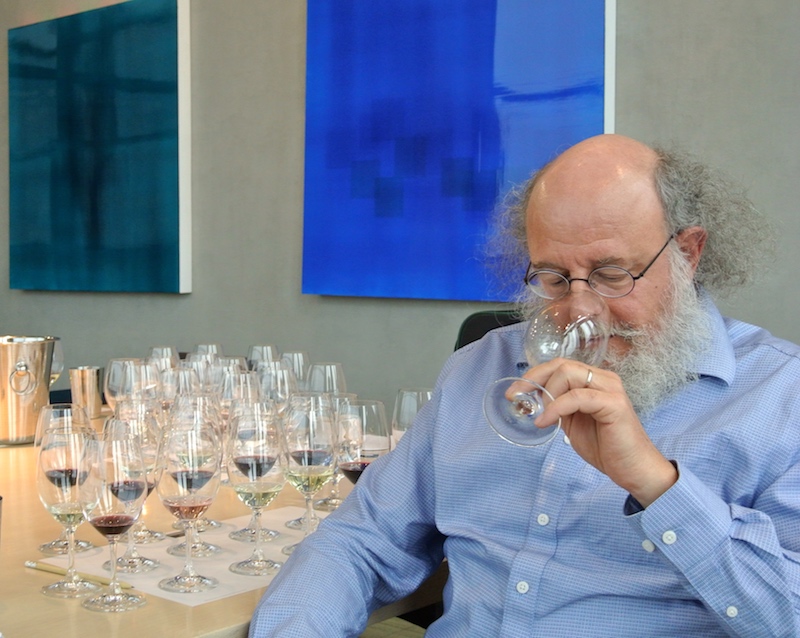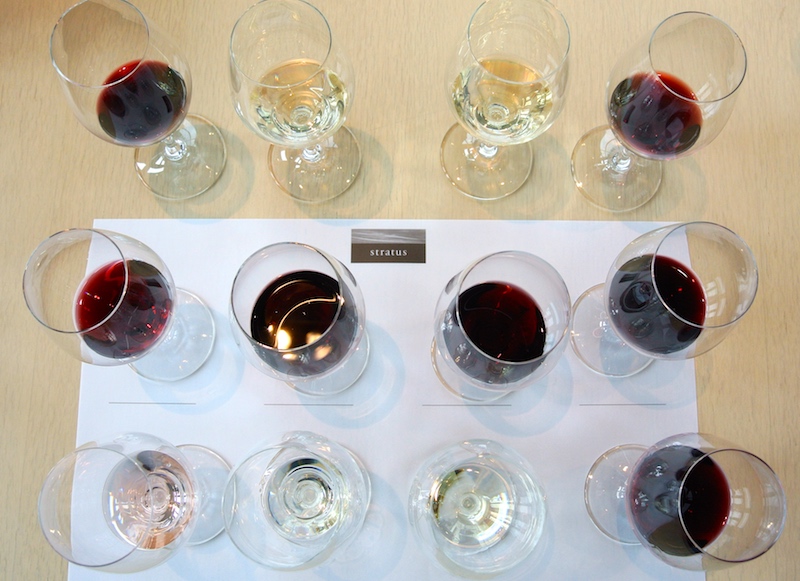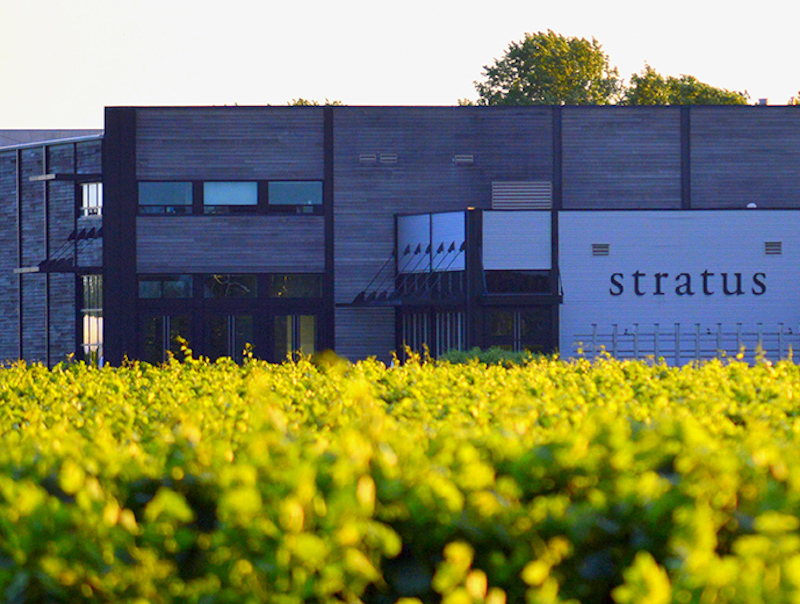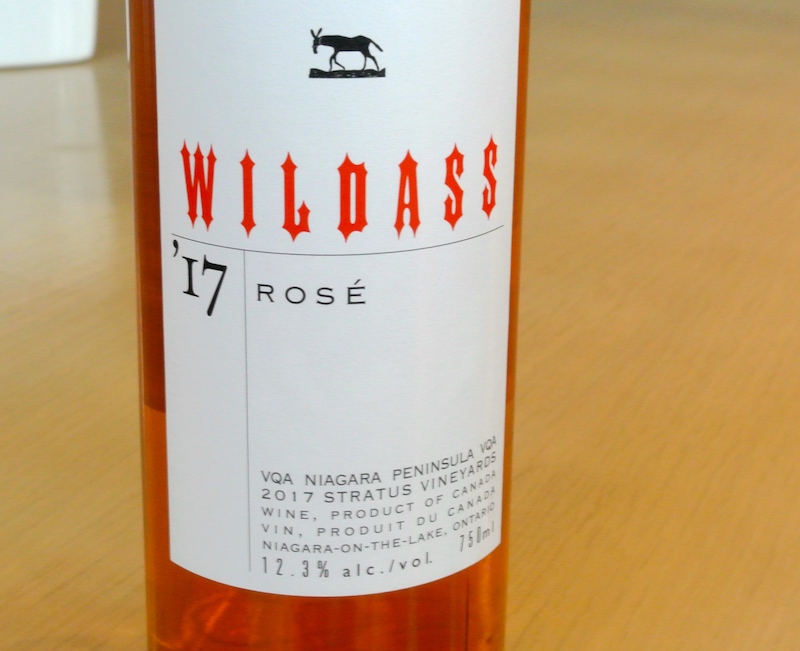
By Rick VanSickle
Winemaker J-L Groux (above) spends an inordinate amount of time carving up the Stratus Vineyard into chaotic little pieces only to be put them all back together again in a much more cohesive fashion.
Well, cohesive is a relative term in Groux’s world of master wine blending at the showpiece Niagara-on-the-Lake winery, the first in the world to be fully LEED certified.
It’s the blending, or the assemblage that Groux likes to call it, that sets Stratus apart from other wineries. It’s a top-down approach that starts with the Stratus Red and White and flows from there. Guided by taste, tradition and a little bit of technology, Groux, newly appointed assistant winemaker Dean Stoyka and the Stratus team combine several estate varietals that have aged sufficiently to reveal their potential to produce the flagship wines. There is no formula for calculating the blend and each vintage presents a unique assemblage of the very best red and white grapes from the estate, which are determined by climate.
It is that vision and steadfast belief in the process that drives Groux, a Loire Valley native who trained in Burgundy and Bordeaux, and was the winemaker at Hillebrand Estates for many years before teaming up with vineyard consultant Peter Gamble to design Stratus’s ultramodern facility in 2000.

“Since then, we’ve put most of our resources and energy into understanding and improving the vineyard: the way we manage and tend our soil, our vines and our grapes,” says Groux. “And as you make a vineyard better, the wine naturally becomes better, too.”
The Stratus Vineyard consists of 55 acres in the Niagara Lakeshore sub-appellation and features three types of clay loam over lacustrine silty clay on a foundation of dolomitic limestone. Forty-five unique blocks within the vineyard have been chosen for their unique soil composition and micro-climate.
Currently, 16 varietals are grown at the estate, 10 red grapes varieties and six white. The selection ebbs and flows as what grows best in the vineyard is better understood. Recently, for example, more Cabernet Franc was added at the expense of Chardonnay.
The estate winery now feeds a portfolio that includes: Stratus wines, the new Weather Report series (basically a second label for Stratus with prices in the high 20s), Wildass (mostly destined for Vintages stores), Tollgate (mostly licensees) and Kabang (exclusively now at Keg restaurants).

I sat down with Groux and estate director Suzanne Janke recently to get caught up on the Stratus portfolio. We tasted only the rosé from the Wildass portfolio (the Stratus Rosé wasn’t quite ready yet and when it arrives will only be sold in magnums), the bulk of the Stratus wines and the new Weather Report wines, which, overall, I found offered great value for the quality of the wines.
Janke also opened what I considered one of Stratus’s most controversial wines — the Stratus Chardonnay 2012 — from the library. When I reviewed this wine a few years ago it was perhaps the most un-Stratus like wine I had tasted. It was voluptuous, buttery, ripe, bold and everything reminiscent of California. Granted it was a hot vintage in Niagara, but this went the full monty warm climate and, I for one, never thought it would last beyond a couple of years. In the short term, however, it was delicious.
Boy, was I surprised when re-tasting this at Stratus. It had lost a lot of the overt buttery, poached pear notes and had become a much more harmonious Chardonnay with the telltale finesse and minerality that Niagara gives you even in warm vintages. It was like silk on the palate, noticeably riper than cooler vintages but more balanced and alive than when first released. It had literally worked its way backwards into a Niagara Chardonnay. Quite amazing, really.
Here’s what I liked from our tasting.

Stratus Wildass Rosé 2017 ($19, 88 points) — This is an unusual assemblage of Sauvignon Blanc, Riesling, Tempranillo and Cabernet Franc that works brilliantly here. It has a slightly more vibrant salmon hue than some of the other Niagara rosés hitting store shelves. It shows a range of crushed red berries, a floral note and grapefruit/citrus accents on the nose. It’s made in a refreshing, crisp style on the palate with bright cherry/raspberry fruits and underlying citrus that keeps everything lively through the finish.
Stratus Chardonnay 2015 ($48, 93 points) — So, a lot going on here. It starts with the best Chardonnay grapes from the Stratus Vineyard picked between Sept. 1-30. Wild yeast, battonage (lees stirring), 287 days in 40% new French oak and then bottled unfiltered with lees. This wine is still alive and evolving when you get it and may gain complexity as it ages in the bottle, so consider cellaring a few bottles. It possesses a beautiful nose of poached pear, fine oak spices (but kept in check), baked apple, underlying minerality/leesy notes and just a touch of lemon. It has wonderful mouthfeel and texture on the palate with concentrated fruits of apple and pear that marry well to the oak spices and minerals. It’s long and luscious on the finish with freshening citrus to keep lively, vibrant and finessed.
 Stratus Semillon 2016 ($32, 92 points) — This lovely, structured Semillon was aged for 220 days in French oak barrels. The nose shows creamy notes on top of apple, peach, pear, pomelo and light spice accents. It has gorgeous texture, rounded orchard fruits and just a lovely and integrated kiss of spice and honey on finish.
Stratus Semillon 2016 ($32, 92 points) — This lovely, structured Semillon was aged for 220 days in French oak barrels. The nose shows creamy notes on top of apple, peach, pear, pomelo and light spice accents. It has gorgeous texture, rounded orchard fruits and just a lovely and integrated kiss of spice and honey on finish.

Stratus White 2014 ($38, 91 points) — This assemblage, always different from previous years and constructed by meticulous blind tasting of the best barrels and blending of the top white varietals grown at the estate, ended up being 54% Chardonnay, 35% Sauvignon Blanc, 5% Sémillon, 5% Viognier and 1% Gewurztraminer. There was a wide window of picking for these grapes, from Sept. 1 to Nov. 20, with the final blend spending 546 days in French oak. It has an overt and expressive nose of tropical fruits, apple skin, peach, apricot and woodsy/savoury spice notes. Certainly a complex white blend on the palate with a range of fruits unlike any other white wine you will taste in Niagara to go with spice, integrated herbs and citrus notes on the finish to keep everything fresh.

Stratus Red 2014 ($48, 89 points) — Like the Stratus White, the Red is built from the top down, so, the best of the red varietals grown at the estate tasted blind by Groux and his team and blended according to the best barrels. This assemblage — from what was not the greatest vintage for red varietals in Niagara — contains 52% Cabernet Franc, 34% Cabernet Sauvignon, 12% Merlot and 2% Syrah and spent 588 days in 35% new oak. It wasn’t easy to craft world-beater reds in Niagara in 2014, but Stratus has fashioned a tasty offering with a nose of raspberry bramble, dark cherry, anise, pepper, cloves and other rich spice notes. It turns earthier on the palate with darkish fruits and peppery/spicy accents on the finish.

Stratus Gamay 2015 ($29, 90 points) — This was previously a much more serious Gamay than the current iteration. Groux has bowed to “what the world wants now” and cut back on oak (now in all neutral French oak barrels) and picked earlier to maintain freshness. This is a likable Gamay with attractive raspberry, plum, crunchy red fruits and light spice and earth on the nose. On the palate, there is still noticeable concentration of fruit that is Groux’s trademark, but it is joined by a vibrant and finessed feel that lights up the red berries and spice notes through the finished. A nice take on this varietal that continues to gain popularity in Niagara.
Stratus Cabernet Franc 2015 ($38, 91 points) — Such a rich and savoury nose of brambly raspberry, cherry and spice with wisps of anise, cedar cigar box and herbs. It’s bright and expressive on the palate with good tannic structure to carry the red fruits, integrated spice notes and anise/licorice highlights on the finish.

Stratus Syrah 2013 ($48, 92 points) — What a wonderful Syrah that hits all the right notes for what I want out of this personable grape. The estate Syrah was picked on Nov. 14 and spent 560 days in French oak, nearly half of which was new. It has a smoky/peppery nose of currants, cassis, Cuban cigar leaf and a range of savoury spice notes. Lovely mouthfeel and racy acidity gets everything popping on the palate. Dark fruits meld with smoke, earth, pepper and savoury spices all delivered on a smooth, long finish.
Stratus Weather Report Viognier 2015 ($26, 89 points) — This late-pick estate Vio sees no new oak whatsoever. It has a nose of rich, ripe apricot, honeysuckle, delicious apple and subtle spice notes. It has some viscosity on the palate with honey-kissed apricot and tropical fruits and ripe apple notes that linger on the finish. An exotic treat.

Stratus Weather Report Chardonnay 2016 ($28, 91 points) — Although this stands in as the “second label” of Stratus, it’s made in exactly the same way as the top Chardonnay, spending nine months in French oak with only 17% of it new. Even in the warm vintage of 2016 in Niagara it shows the direction winemaker J.L. Groux is taking with this varietal: a more finessed approach to the finished wine to better reveal the minerality of the vineyard. The nose shows lovely crisp apple, citrus, pear, light toast and spice with underlying minerality. It’s fresh, finessed and lively on the palate with integrated orchard fruit, spice and flinty minerality on the finish. Cool climate Chard in a warm vintage? Mission accomplished.

Stratus Weather Report Red 2013 ($29, 90 points) — The assemblage of this second “Red” from Stratus contains 32% Cabernet Franc, 23% Cabernet Sauvignon, 14% Petit Verdot, 10% Merlot, 9% Syrah, 8% Viognier and 4% Tempranillo that’s aged for 552 days in French oak, 25% of which is new. What possesses a winemaker to toss all that into a red blend after blind tasting all the barrels at the estate? Just when he thinks he’s nailed the blend, Groux goes that one step further … and adds Viognier and Tempranillo into the mix, thus ensuring there is absolutely no other wine in Niagara, Ontario, Canada?, the planet? with a similar profile. Somehow it all works here. The nose shows smoky/spicy raspberry and cherry fruit, herbs and black currants that are all nicely integrated. It is smooth on the palate and ready to drink right now with nicely integrated red fruits, spice and tannins. Delicious red wine with perfect bottle age.
 Stratus Weather Report Cabernet Franc 2015 ($28, 91 points) — This inaugural Cabernet Franc from the new Weather Report series is a pretty nice drop at an attractive price. It shows a vibrant, intense colour in the glass with aromas of brambly raspberry, dark cherry, earth, currants, spice, vanilla and subtle herbs. It has intensity on the palate with flavours of wild raspberry, anise, tobacco, herbs and integrated spice with ripe, approachable tannins that all lead to a smooth finish. Can drink now or hold 3+ years. P.S. Only 12.8% abv.
Stratus Weather Report Cabernet Franc 2015 ($28, 91 points) — This inaugural Cabernet Franc from the new Weather Report series is a pretty nice drop at an attractive price. It shows a vibrant, intense colour in the glass with aromas of brambly raspberry, dark cherry, earth, currants, spice, vanilla and subtle herbs. It has intensity on the palate with flavours of wild raspberry, anise, tobacco, herbs and integrated spice with ripe, approachable tannins that all lead to a smooth finish. Can drink now or hold 3+ years. P.S. Only 12.8% abv.






Comment here